
Andy Lloyd's Dark Star Blog

Blog 16 (July 2014)
Two Suns Once Again
Lee Covino has pointed out to me some ancient art showing a clear depiction of two suns in the sky. Now how could that be, in a solar system containing just one Sun? It's a bit of a mystery to anyone not acquainted with the Dark Star Theory, but regular readers will be smiling knowingly. Let me explain:
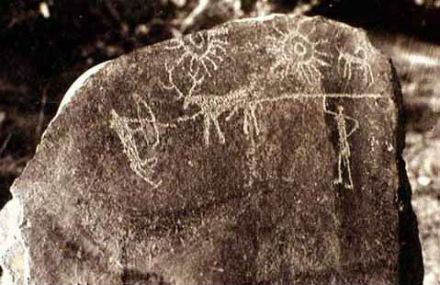
Photo source: Kashmir Network
Back in the 1960s, Indian archaeologists working at Burzahom (an ancient Neolithic site in India's mountainous area of Kashmir) discovered an ancient carved stone slab in showing two suns in the sky above what seems to be a hunting scene (figure 1)(1). There are a couple of hypotheses doing the rounds about what this scene is meant to portray:
"An interesting discovery made at Burzahom was a carved stone slab that shows two hunters hunting a stag, while twin suns shine in the sky. The presence of two similar suns in the sky is a mystery. Some researchers believe that the Neolithic artists depicted two suns to indicate the duration of the hunt (e.g. two days), while a far more exotic theory has been proposed by a team of astronomers who believe that the scene represents the ancient night sky with the two suns actually representing the moon and a supernova, while the hunters and the animals represent constellations like Orion and Taurus." (2)
The Orion/Taurus idea isn't so far-fetched - the horizontal line through the stag/Taurus could be the line of the ecliptic, for instance, although slightly askew.
Occupation dates for the Burzahom site vary, going back perhaps as far as 6000 BCE to as recently as 1000 BCE, but more likely 3000-1500 BCE. It's not clear when during that extensive time period this carving was made, although some stonework dating from the site suggests 2100 BCE (3). Radio-carbon dating of the site provides us with the date 2375 BCE (4).
The best fit for a supernova during the prehistoric period is argued to be that of the supernova remnant (SNR) HB9, near the star Capella in the constellation Auriga (3). While it's not certain exactly when this supernova occurred, the evaporative cloud model suggests dates between 2000-5000 BCE, and the Sedov age for an SNR more specifically suggests about 4600 BCE (5). If the carving does indeed depict a region of the sky dominated by Orion and Taurus, then the left hand 'sun' would be a reasonably close fit for the position of this supernova, although these dates extend back into a less certain period of site occupation.
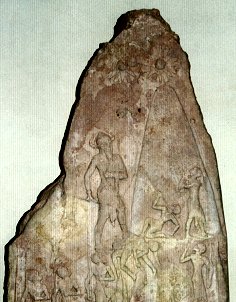
The Victory Stele of Naram-Sin at the Louvre, Paris.
Image credit: Andy Lloyd
But it's hard to see why the ancients might have depicted the Moon in this self-evidently solar manner. If these are constellations, then one still needs to explain the occurrence of the two suns. If one is the Sun, the other a supernova, then the supernova would have to have been seen in the daylight, which seems unlikely - even the 1572 supernova was only barely visible during the daytime (6).
Compare the Burzahom stone carving with the Victory Stele of the Akkadian King Naram-Sin (figure 2), which also clearly depicts two suns. This Mesopotamian stone stele dates to around 2230BCE during the period of the King's reign (7). Note that this actually fits rather well with standard dating for the Burzahom site in Kashmir. The stele shows the victorious, rather over-sized King Naram-Sin lording it over his vanquished foes, the Lullibi tribe of the Zagros Mountains. This dramatic scene takes place below a sky which includes two suns:
"...the conqueror's gaze is directed toward the top of the mountain. Above Naram-Sin, solar disks seem to radiate their divine protection toward him, while he rises to meet them. The Akkadian sovereign wears a conical helmet with horns - a symbol traditionally the privilege of the gods - and is armed with a large bow and an axe." (8)
The bow-carrying Naram-Sin is also suggestive of Orion, I think, and he is orientated in relation to the two suns in a very similar way to the hunter carved into the ancient Kashmiri stone at Burzahom. Coincidence? It's perfectly possible that both of these carvings were made about the same time, some 4,200 years ago. Are they both intended to depict the same event - some kind of sighting on an anomalous stellar object in the sky?
The depiction of the second sun on the Akkadian victory stele suggests something else to me. If this scene does indeed show a skymap, might the 'mountain' on the victory stele of Naram-Sin represent something to do with the sky, rather than a singular Zagros mountain? We've already seen how the position of the ecliptic through Taurus would be a rather more straight line. So what is this 'mountain' supposed to be? The parabolic curve of the mountain might also be interpreted in one of two quite different ways:
Commemorative stone from the Marduk Temple,
Babylon ~900BC (British Museum, ME 90834)
Photo Source: Andy Lloyd
Firstly, the 'mountain' combined with the second Sun above it (which Naram-Sin (aka Orion) looks up towards) might be suggestive of an extremely bright, massive, vertically-aligned comet edging towards the Sun during perihelion.
Secondly, the parabolic curve might be suggestive of the orbital path of the 'second sun' through the ancient sky-map, in the manner of a comet moving through its perihelion passage.
This arch-like 'mountain' appears in other Mesopotamian carvings featuring celestial imagery. For instance, a Babylonian commemorative stone from around 900 BCE, housed in the British Museum (9), shows the Winged Disc and Moon close to such an archway, with the main figure orientated in a similar fashion to the victory stele (figure 3). This particular stone is from a temple of Marduk, a god closely associated with the Dark Star.
It strikes me that these common images are suggestive of an extraordinary event that took place in the sky. The best fit for a supernova event is some 2500 years out of kilter with the timing of the carvings, which is a bit of a snag. So, is this Nibiru? Is this the return of the Dark Star, our solar system's own 'second sun'? Well, if so, then the timings of this event also raise some new questions. One advantage is that a return during this period might explain why Nibiru was spoken of as a red star in Babylonian astrolabes (10). Whilst many uncertainties remain, this 'new' depiction of the twin suns provides us with an intriguing new piece of evidence for something highly anomalous in our ancient skies.
Written by Andy Lloyd, 18th July 2014
References:
1) Khazanchi T N, "Explorations and Excavations in Jammu and Kashmir, Archaeological Survey of India report 1964-65", ed. A Ghosh, 1969, p13
2) April Holloway "Protection sought for mysterious Neolithic site of Burzahom" 20 June 2014, with thanks to Lee
3) Hrishikesh Joglekar, M N Vahia, Aniket Sule "Oldest sky-chart with Supernova record", Puratatva, 2006,
4) UNESCO "The Neolithic Settlement of Burzahom"
5) Leahy, D. A. & Tian, W. W. "Radio spectrum and distance of the SNR HB9" Astronomy and Astrophysics, 461(3): 1013-1018, January 2007
6) Larry Sessions "10 surprising space objects to see in the daytime sky" 16 June 2014
7) "Naram-Sin of Akkad"
8) "Victory Stele of Naram-Sin"
9) Andy Lloyd "British Museum Evidence" 2 July 2011
darkstar1.co.uk/britishmuseum.htm
10) Andy Lloyd "Dark Star: The Planet X Evidence" Timeless Voyager Press, 2005, pp48
Tiamat was a 'Super-Earth'
Astronomers have been hunting for Planet X for over 100 years, and the idea of such a body has been in and out of fashion in scientific circles in equal measure during that time. Right now, many astronomers are quite open to the idea because of an array of anomalies in the outer solar system which beg for another planet or two in order to square the circle (1). Furthermore, theoretical objections to the existence of a massive Planet X body stemming from the standard core-accretion model for planet formation have been taken apart by the sheer wondrous diversity of exoplanets observed in other star systems.
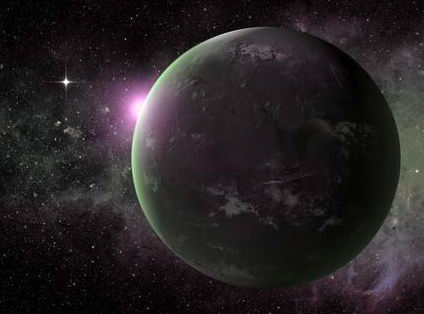
The abundance of 'hot Jupiters' and 'super-Earths'
elsewhere don't reflect the pattern of planets familiar to us from our
own solar system, let alone the diversity of wildly eccentric orbital
paths of many exoplanets. I guess it's a bit like kids growing up
who assume that their parents are normal, until they start to meet the
regular folks in the real world. Our family is far from normal, it
seems! Weird is the new normal as far as planetary science is
concerned.
"Perhaps the biggest question is why
our Solar System is so different. Why doesn't it contain the one kind of
planet most common around other Sun-like stars? Why are there no planets
inside Mercury's orbit when that's where most of the exoplanets are in
other systems? Why do we have a balance of large and small planets when
most other systems seem to choose one or the other but not both?"
(2)
The most common form of planet so far turns out to be 'super-Earths', which are planets whose mass lies somewhere between that of Earth and Uranus (3) (although the statistics might be skewed by a bias towards finding larger planets). They might be terrestrial, they might be predominantly gaseous, so conditions on these worlds very greatly. Although gravitational conditions on these worlds are likely to be greater than those on Earth, oceanic life would still be entirely possible on suitably endowed aqueous worlds as the buoyancy of the waters would counteract the higher gravity (4). And the size of these worlds lends itself well to these kinds of conditions.
According to Zechaira Sitchin, the origins of the solar system were also very different to the standard model. His notions of the formation of the solar system included two planets which are apparently missing from the current line-up (5). The biggest was a planet associated with the ancient Babylonian god Marduk - the fiery, rogue 'planet' which I have argued is a sub-brown dwarf still lurking in the (very) outer solar system (6). Well, it turned out that these kinds of tiny 'failed stars' are pretty commonplace, even though they were barely considered on a theoretical level back when Sitchin first started writing about his alternative cosmology.
The second 'missing' planet was Tiamat, a massive watery world which was initially stationed between Mars and Jupiter. This terrestrial world was covered in oceans, and was subject to a cosmic collision with one of the moons of the fiery, rogue planet Nibiru/Marduk. The giant interloper then flung the wounded Tiamat inwards, becoming the smaller, warmer Earth now lying some 3-4 times closer to the Sun.
This was pretty radical stuff back in the 1970s, during a time when the solar system was considered to be an eternal model of orderliness. Now we know that the solar system orderliness is more O.C.D. than normality. In that respect, Sitchin was right. He may also have been right about the nature of Tiamat. Essentially, he predicted the 'super-Earth' planet, which did not feature in the standard models of planet formation prevalent at the time. Where modern astrophysicists wonder why the solar system doesn't have its own super-Earth, Sitchin's writings echo down to us: "It did"!
Written by Andy Lloyd, 19th July 2014
References
1) Andy Lloyd "The Kozai Effect and our Haunted Solar System" 23 June 2014
andylloyd.org/darkstarblog15.htm
2) Ann Finkbeiner "Astronomy: Planets in chaos" 2 July 2014 with thanks to Lee
3) Elizabeth Howell "Alien Super-Earth Planets Plentiful in Exoplanet Search" 3 December 2013
4) Fraser Cain "What is a Super Earth?" 27 January 2014
5) Zecharia Sitchin "The Twelfth Planet" Avon, 1976
6) Andy Lloyd "Dark Star: The Planet X Evidence" Timeless Voyager Press, 2005
![]() The Dark Star: The Planet X Evidence
The Dark Star: The Planet X Evidence
The Origin of Ancient Titan
Recent measurements of the nitrogen isotope ratio in cometary ammonia,
compared to those in the atmosphere of Saturn's moon Titan, have provided strong evidence that the nitrogen in Titan's atmosphere originated as ammonia ice formed in the protosolar nebula under conditions similar to that of cometary formation (1)."The nitrogen in the atmosphere of Saturn's moon Titan seems to have gotten its start as ammonia ice in the early solar system. The finding suggests that the essential building blocks of Titan formed under similar conditions as ancient comets in the Oort cloud, not in the warm disk that surrounded Saturn when the planet was young
. ESA’s Rosetta mission could confirm the results later this year when it studies comet 67P/Churyumov-Gerasimenko. The comet is from the Kuiper Belt and should have slightly different chemistry than anything originating in the Oort cloud. The results also provide hints as to how Earth got its atmospheric nitrogen, the scientists say." (2)So, in effect, Titan
may be a captured object from the outer solar system. Either that, or all of its ammonia ices were dumped onto its surface sometime after its formation by impacting comets originating from the Oort Cloud.
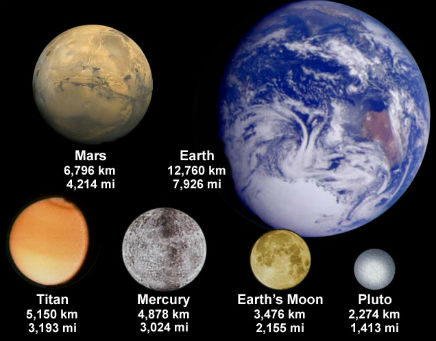
In her press conference, Kathleen Mandt, the scientist leading the work on Titan's nitrogen isotopic composition, argued that Titan's nitrogen cannot have naturally evolved - from an origin in Saturn's warm sub-disk to what it looks like now - within the lifetime of the solar system:
“Titan’s atmosphere contains so much nitrogen that no process can significantly modify this tracer even given more than four billion years of Solar System history.” (3)
This implies Titan originated somewhere else, probably the Oort Cloud (4). Furthermore, the eccentricity of Titan's orbit also suggests its origin was not part of the normal process of formation of Saturn's system of moons, adding to the argument that a comet-like planet Titan may have been captured by Saturn:
"Titan overwhelmingly dominates Saturn's system and possesses a high orbital eccentricity not immediately explained by co-accretion alone." (5)
Some years ago, scientists argued that all planets began life in the protoplanetary disk that swirled around the Sun, and argued that Planet X-like bodies were unlikely because there was no theoretical underpinning for how they formed. More recently, that fairly blinkered vision about how planets form has been disrupted by knowledge of the often extreme variation of extra-solar planetary systems.
So, we now know that planets can form in the outer zones of planetary systems, allowing for the creation of 'moons' like Titan.
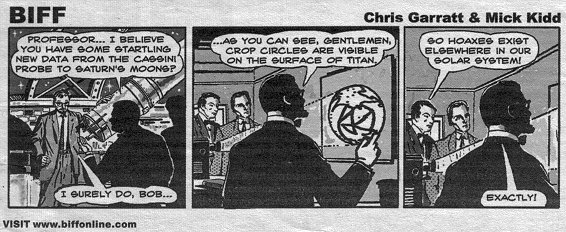
Titan gets its name from its size - it's bigger than Mercury. In effect, it's really more or less a bona fide planet with its own atmosphere. Therefore, for such an object to form out in the Oort Cloud is a very exciting prospect for Planet X hunters! It also begs the question as to whether Titan might have more in common with the Dark Star than with its adopted 'master', Saturn. I wrote to Kathy Mandt to ask her opinion about whether Titan was a captured object, but she did not reply. However, I did manage to speak with an academic astronomer friend of mine - specialising in asteroids and comets - and his opinion was that it wouldn't be any kind of surprise at all.
Written by Andy Lloyd, 19th July 2014
References
1) Kathleen E. Mandt et al. "Protosolar Ammonia as the Unique Source of Titan's Nitrogen" The Astrophysical Journal Letters, 788: L24, 2014
2) Ashley Yeager "Titan's origins linked to Oort cloud" 2 July 2014, with thanks to John
3) NASA Press Release "Titan's Building Blocks Might Pre-date Saturn" 23 June 2014
4) Dragos Matrica "Saturn’s moon Titan may be older than Saturn itself" 26 June 2014
5) "Titan (moon)"
Missing Links
Speaking of the Anunnaki and their alleged intervention in our early evolution, there has been a recent development in science regarding the lineage of the Neanderthals. It seems as though proto-humans and proto-Neanderthals may have parted company over 400,000 years ago, with the later modern humans Neanderthals and developing their large brains separately after that.
Image credit: Robert Clark. Source: Matthias Meyer, Max Planck Institute, and
Juan Luis Arsuaga, Universidad Complutense de Madrid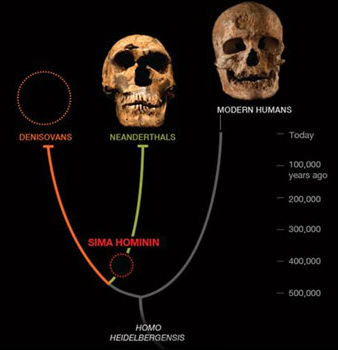
This whole area of scientific research remains challenging, not least because of a paucity of what are scattered fossil remains:
"Researchers have long debated when and where Neandertals arose. Neandertals stem from the same root as our own ancestors, but the two lineages parted ways sometime in the past 500,000 years or so. Modern humans arose in Africa at least 200,000 years ago, whereas the fossils of Neandertals are found only in Europe and Asia after 230,000 years ago. Between about 200,000 and a million years ago, our view of human origins is blurred—most of the fossils of hominins, or members of the human family, are isolated, fragmentary, or spread widely across Europe, Asia, and Africa." (1)
A form of archaic Neanderthal has been discovered from fossil remains in the Atapuerca mountains of northern Spain, 17 skulls of which appear to date back as far as 430,000 years. There is a consensus belief in archaeological circles that the lineages that gave rise to modern humans and the Neanderthals had already parted by this time (1).
How does this fit in with the arrival of the Anunnaki? This timeline bears some resemblance to that provided by Zecharia Sitchin in his book "The Twelfth Planet":
"If the Nefilim first landed on Earth, as we have concluded, some 450,000 years ago, then the creation of Man took place some 300,000 years ago! The Nefilim did not create the mammals or the primates of the hominids. "The Adam" of the Bible was not the genus Homo, but the being who is our ancestor - the first Homo Sapiens." (2)
The gap between the arrival of the Nefilim, and their intervention to genetically engineer modern humans is attributable to a period of "40 periods" mentioned in the Mesopotamian texts, during which the colonists themselves 'toiled upon the Earth'. Sitchin argued that these 40 periods amounted to 144,000 years, where 1 period = 1 Shar of 3,600 years (2).

The most significant interglacial period in the last 800,000 years occurred around 400,000 years ago, as can be seen on the chart opposite. Presumably, this extensive period of warm global conditions allowed hominin species extant at that time to further spread out across the globe, leading to the diversification of the various, more modern lineages.
So, where does Sitchin's theory of modern human origins fit into all this? If his timings are correct, then it was not just the humans whose brain sizes leapt forward during the period in question. Neanderthals also saw a similarly significant uplifting of brain capacity, although their lineage was evolving along a different genetic path by then. Did the Anunnaki experiment with both races, breeding each perhaps for different functions? It seems likely. Let's consider the conventional alternative:
If this is simply all down to evolution by natural selection, then why did these comparatively similar upgrades of brain capacity occur simultaneously among humans and Neanderthals, separately? This is a crucial question acknowledged, but seemingly ducked by writers commenting upon the Sima de los Huesos ("pit of bones") findings in the Atapuerca mountains:
"In addition, if these small-brained Sima fossils are indeed ancestral only to Neandertals, then our cousins must have evolved their big brains independently from us. Rather than inheriting big brains from a common ancestor, Neandertals and modern humans each developed that trait on their own, perhaps favored by changes in climate, environment, or tool use experienced separately by the two species “more than half a million years of separate evolution,” writes Jean-Jacques Hublin, a paleoanthropologist at the Max Planck Institute for Evolutionary Anthropology in Leipzig, Germany, in a commentary in Science (3)."" (2)
This seems to me to be a rather weak argument. Given the seeming 'miracle' of big brain development, it beggars belief that two such miracles seem to have occurred separately during the same time period. To my mind, the interventionist model still provides more answers than the conventional one regarding this very sticky issue.
Written by Andy Lloyd, 19th July 2014
References:
1) Ann Gibbons "Fossils put a new face on the ancestors of Neandertals" 19 June 2014
2) Zecharia Sitchin "The Twelfth Planet" Avon, 1976, p340-1
3) Jean-Jacques Hublin "How to build a Neandertal" Science, 344 (6190):1338-1339, 20 June 2014
Scotland's Curious Cochno Stone
Scottish authorities are considering unearthing (literally) a rather remarkable 5000 year-old artifact buried more or less in a rural Glaswegian garden.
"The Cochno Stone in West Dunbartonshire bears what is considered to be the finest example of Bronze Age “cup and ring” carvings in Europe. The stone, which measures 42ft by 26ft, was discovered by the Rev James Harvey in 1887 on farmland near what is now the Faifley housing estate on the edge of Clydebank. It is covered in about 90 carved indentations, or “cups”, and grooved spirals, along with a ringed cross and a pair of four-toed feet.
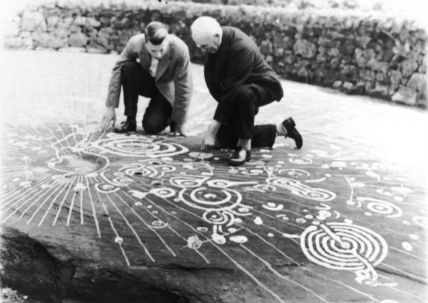
"In 1964, Glasgow University archaeologists recommended it should be buried under several feet of soil to protect the carvings from further damage by vandals. The stone has been covered ever since." (1)
Fancy covering it up with soil and brambles (2)! I guess that even in the 1950s the locals believed was that this was some kind of ancient witchcraft, or at the very least Pagan sorcery - many Scots take their religious preoccupations rather more seriously than we lackadaisical English do. Given the tide of Scottish Nationalism rampant at the moment, I guess this old stone might really see the light of day after all - if only to reinforce how cultural styles differed so widely compared with their southern cousins (c.f. Stonehenge), even as far back as 5000 years ago.
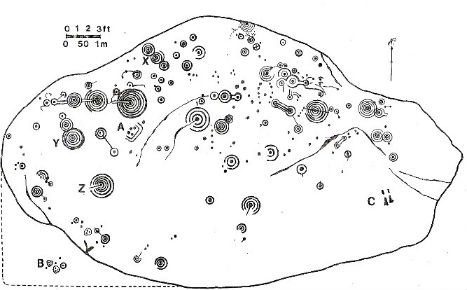
Photo Source, with coordinates of the Cochno Stone:
The 'cup and ring' petroglyphs bear an uncanny resemblance to modern-day crop circles, stylistically at least. If this artifact had lain in Wiltshire, rather than West Dumbartonshire, then I would have been seriously agog. As it is, Highland heather does not lend itself readily to circle-making. It tends to bounce back.
Written by Andy Lloyd, 21st July 2014
References:
1)
Craig Brown "5000-year-old Cochno Stone carving may be revealed" 17 July 2014 with thanks to Lee2) May Miles Thomas "The Devil’s Plantation: trip twenty five" 7 September 2008
devilsplantation.co.uk article

You can keep informed of updates by following me on Twitter:
![]()
Or like my Facebook Page: https://www.facebook.com/darkstarandylloyd